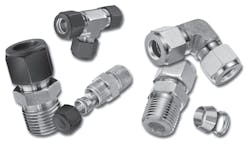In the world of instrumentation, there are a number of different topics discussed and analyzed. However, one that should not be overlooked is that of instrumentation fittings. Do you know what technologies are available? Do you know the strengths and weaknesses? Are there any new trends?
There is a wealth of information to consider when determining the best choice for a specific application. There are safety implications, cost considerations and efficiency requirements that must be considered. Safety engineers, reliability engineers, plant managers and safety/quality engineers must keep these things in mind when selecting and implementing this type of instrumentation into a process. The discussion inevitably begins with considering the similarities and differences between a single and a double ferrule fitting.
Single vs. double ferrule instrumentation fittings
One of the very first choices to make for compression fittings is whether the application should be approached with a single or double ferrule fitting. Both the single and double ferrule design have been around for more than 50 years.
Over the years, the double ferrule design has dominated the industry, due to certain patents and specific market penetration. That is not to say, however, that a double ferrule design is always desired. One specific area where the single ferrule is unquestionably desirable is in reliability in the assembly. Due to the nature of the design, there are 14 ways someone can incorrectly put together a double ferrule fitting. But there are only two ways a person can incorrectly assemble a single ferrule fitting. Keeping in mind this fact, a plant may be better off moving forward with a single ferrule design for safety purposes.
For most plants, safety is a top priority. Many plants will have committees dedicated to examining products and processes that directly address safety. These committees are always aiming to implement safety solutions and analyze the metrics to ensure these solutions are effective (near misses, lost time, etc.). Furthermore, as turnover is always a challenge for processing plants, oil and gas refineries, power plants and chemical plants, there are always new employees who must go through some degree of safety training on a monthly, quarterly or annual basis. By simplifying the assembly of the tube fittings, there are positive safety implications.
Corrosion resistance
After zeroing in on the design that best fits the needs of a particular operation, the next element that should be taken into consideration is corrosion resistance. Why? Other than the headaches and anxiety corrosion can cause operators, there are significant economic implications if corrosion is left unaddressed. On the extreme side, corrosion in ferrules can cause equipment to fail and possibly cause a complete shutdown. More frequently, corrosion can contaminate whatever product is being produced or, at the very least, drastically impact the efficiency at which it is produced. Finally, reactive and preventive maintenance costs rise when corrosion is not planned for or corrected.
How is corrosion addressed in ferrules?
The leading edge of the ferrule must be hardened and there are different processes that are implemented by manufacturers to achieve this, making the ferrules more resistant to corrosion. There are two types of corrosion to be aware of: process and external. Process corrosion affects what is actually going through the tube. External corrosion, on the other hand, reflects the outer environment that surrounds the operation. If either of these types of corrosion are ignored, the process can be riddled with problems that will lead to system failure.
Lubrication
In both single and double ferrule fittings, there needs to be lubrication on the inside threads of the nut (due to the stainless-steel design) to prevent galling. Single ferrule tube fittings, more often than double ferrule fittings, are lubricated with a coating known as Molybdenum Disulfide (Moly). This is widely considered to be a superior lubrication to the alternatives due to its properties under conditions of high temperature, vacuum and corrosive environments. This process allows for an increased number of remakes without increasing the torque of the fitting. Moly also provides for superior temperature values. Double ferrule fittings will more often use a different type of lubrication. Silver plating is used in most leading brands of double ferrule nuts.
Heat code traceability
Regardless of the type of fitting an operator ultimately decides to choose, heat code traceability is a critical element to understand. This is true any time an operator is introducing a fitting into a new environment. Whether discussing this introduction into a refinery, power plant or nuclear plant, safety is the number one priority. It is taken very seriously in these high-risk environments, and rightfully so. Anyone who has experience introducing elements to a refinery or nuclear plant understands that these environments all require traceable documentation. For safety purposes, the pedigree of the material and the location the material came from and passed through must be documented. This makes heat code traceability of the utmost importance. In the process industries, anything that goes into a process application will require this documentation.
When it comes to instrumentation fittings, there is a fair amount that should be discussed on the front end before introducing new elements into an operation. A plant manager needs to understand his or her options before making a decision on what direction to take. These decisions should be influenced first and foremost from a safety perspective, including a complete understanding of the products’ heat code traceability. Next, one should consider the design, corrosion resistance and lubrication characteristics of the fittings before ultimately settling on a decision.
Greg Neneman is the Director of Business Development for Valin Corporation, a leading technical solutions provider for the technology, energy, life sciences, natural resources and transportation industries. Valin offers personalized order management, on-site field support, comprehensive training and applied expert engineering services utilizing automation, fluid management, precision measurement, process heating and filtration products. For more information, please visit https://www.valin.com.
